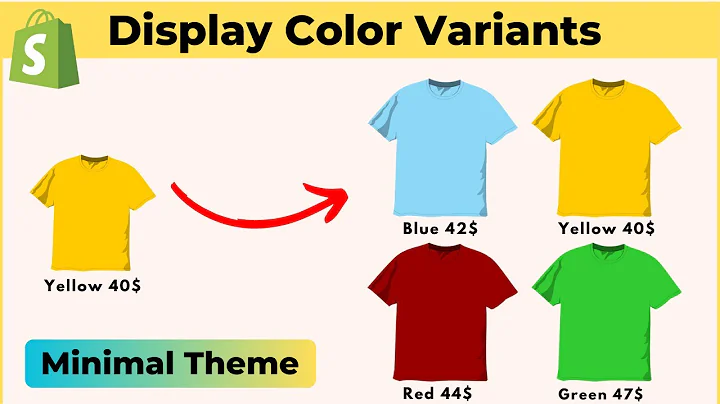Streamline Your Sales: Connect and Import Shopify to eBay
Table of Contents
- Introduction
- Getting Started with Shopify and eBay Sync
- Connecting Shopify as the Source Channel
- Connecting eBay as the Target Channel
- Setting Up Sync Settings
- Mapping Categories
- Manipulating Product Fields and Settings
- Exporting Shopify Products to eBay
- Configuring Export Settings
- Reviewing the Product on eBay
- Conclusion
Introduction
In this article, we will guide you through the process of exporting and syncing your Shopify products to eBay. With just a few easy steps, you can expand your reach and seamlessly maintain product updates across both platforms. We will walk you through the setup, explain the necessary connections, and provide tips for optimization. So, let's get started and unlock the potential of Shopify and eBay synchronization.
1. Getting Started with Shopify and eBay Sync
Syncing your Shopify store with eBay opens up a new avenue for selling your products. By exporting your products to eBay, you can tap into a larger customer base and increase your sales potential. In this section, we will cover the initial steps to set up the synchronization between the two platforms.
2. Connecting Shopify as the Source Channel
To export your Shopify products to eBay, you need to establish a connection between the two platforms. This section will guide you on how to connect your Shopify store as the source channel. We will explain how to input your Shopify URL and choose a recognizable nickname. Additionally, a step-by-step guide to installing the necessary app for Shopify integration will be provided.
3. Connecting eBay as the Target Channel
After connecting Shopify as the source channel, you need to establish a connection with eBay as the target channel. This section will walk you through the process of selecting your eBay store country, choosing a nickname, and establishing the connection between Shopify and eBay. We will also address any concerns regarding browser compatibility and provide troubleshooting tips.
4. Setting Up Sync Settings
Once the connection between Shopify and eBay is established, it's crucial to configure the sync settings to ensure smooth product synchronization. In this section, we will address options such as autofixing SKUs, which is essential if you don't have SKUs in your products or require automatic SKU assignment. We will provide a brief explanation of each sync setting option.
5. Mapping Categories
For a seamless transition from Shopify to eBay, it's essential to map your product categories accordingly. This section will guide you on how to map your Shopify categories to the corresponding eBay categories. We will provide a step-by-step process of finding the best match and explain how to remap the categories if needed. Mapping categories only needs to be done once for each category.
6. Manipulating Product Fields and Settings
To optimize your products for eBay, you have the flexibility to manipulate various product fields and settings. This section will explore the possibilities of modifying product descriptions, removing HTML formatting, adjusting pricing for eBay, and more. We will delve into the rule settings and provide examples of how different fields can be manipulated.
7. Exporting Shopify Products to eBay
It's time to export your Shopify products to eBay and witness your listings come to life on the new platform. In this section, we will walk you through the export process step by step. We will guide you on how to configure payment profiles, shipping profiles, return policies, and set the default location for the products to be exported. This section will also highlight the flexibility to modify export settings at any time.
8. Configuring Export Settings
Before exporting, it's crucial to configure the export settings according to your needs. This section will guide you through the process of setting up payment profiles, shipping profiles, return policies, and default locations for the products being exported to eBay. We will emphasize the importance of creating these profiles and provide tips for a quick and efficient setup.
9. Reviewing the Product on eBay
After successfully exporting your Shopify product to eBay, it's essential to review how the listing appears on the platform. This section will guide you on how to view the product on eBay and ensure that all images, descriptions, and variations from your Shopify listing are seamlessly imported. We will provide a quick walkthrough of the review process and highlight the importance of a professional-looking listing.
Conclusion
In conclusion, exporting and syncing your Shopify products with eBay is a simple yet powerful way to expand your reach and boost sales. In this article, we covered the step-by-step process of setting up the synchronization, connecting Shopify as the source channel, connecting eBay as the target channel, configuring sync settings, mapping categories, manipulating product fields and settings, exporting products, and reviewing the listing on eBay. By following these instructions, you can maximize the potential of both platforms and increase your online presence. Subscribe for more tips and visit exploreyourstore.com for additional support.
Highlights
- Exporting Shopify products to eBay is a simple process that can significantly expand your sales potential.
- By syncing your Shopify store with eBay, you can seamlessly maintain product updates on both platforms.
- Connecting Shopify as the source channel and eBay as the target channel is the first step in the synchronization process.
- Configuring sync settings allows you to autofix SKUs, manipulate product fields, and optimize listings for eBay.
- Mapping categories ensures that your Shopify categories align with the corresponding eBay categories for a seamless transition.
- Exporting Shopify products to eBay is quick and straightforward, with the ability to customize payment and shipping profiles.
- Reviewing the product on eBay ensures that all images, descriptions, and variations from your Shopify listing are accurately imported.
FAQ
Q: Can I sync my existing Shopify products with eBay?
A: Yes, you can sync your existing Shopify products with eBay by following the steps outlined in this article. Connecting Shopify as the source channel and eBay as the target channel will enable you to export and sync your products seamlessly.
Q: Can I make changes to my products after exporting them to eBay?
A: Yes, you can make changes to your products even after exporting them to eBay. Shopify and eBay sync allows for a dynamic update process, where any changes made to your products on Shopify will be reflected on eBay.
Q: Can I customize the pricing for my products on eBay?
A: Yes, you have the flexibility to adjust the pricing for your products on eBay. By modifying the pricing settings in the export configuration, you can set a specific percentage increase or decrease from your Shopify pricing.
Q: Can I optimize my product descriptions for eBay?
A: Absolutely! You can optimize your product descriptions for eBay by removing HTML formatting or making any necessary modifications. The rule settings in the sync configuration allow you to manipulate various product fields to suit the eBay platform.
Q: Can I map my Shopify categories to different eBay categories?
A: Yes, you can map your Shopify categories to different eBay categories based on your preferences. Mapping categories helps ensure that your listings appear in the relevant eBay categories, allowing potential customers to find your products easily.






















